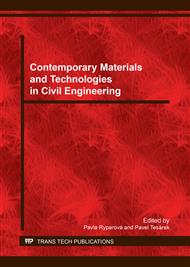p.15
p.23
p.29
p.37
p.43
p.49
p.55
p.60
p.66
Time Depend Wettability Deterioration of Plasma Treated Polymeric Macro-Fibers
Abstract:
Presented work is focused on the time depend wettability deterioration of plasma treated polymeric macro-fibers. The commercial fibers designed especially for reinforcement of concrete composites – Concrix ES (made from polyolefin) and BeneSteel (polyethylene and polypropylene mixture) were surface modified by oxygen cool low-pressure coupled plasma to attain their water wettability enhancement. The wettability development of thus treated fibers was observed through contact angle sizes between fiber surfaces and distilled water using a direct horizontal optical static method. Contac angle measurements were realized (i) immediately, after (ii) 1 day, (iii) 7 days and (iv) 30 days over the treatment execution, while fibers were stored on the air on standard laboratory condition in the meantime (temperature ~22 °C, moisture ~50 %). Both, the treated Concrix ES and BeneSteel fibers exhibited significant wettability increase. The enhanced wettability of modified fibers stayed approximately constant even after 30 days over the treatment execution in the case of BeneSteel, while in the case of Concrix ES the wettability decreased almost to the reference (no treated) samples, respectively.
Info:
Periodical:
Pages:
43-48
Citation:
Online since:
March 2017
Authors:
Keywords:
Price:
Сopyright:
© 2017 Trans Tech Publications Ltd. All Rights Reserved
Share:
Citation:


